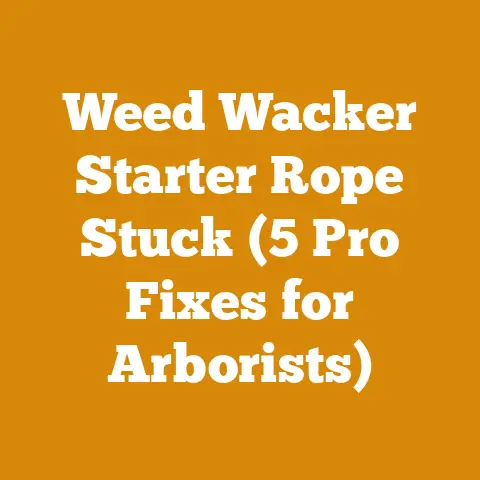Hydraulic Oil Conditioner Tips (5 Pro Tricks for Woodworkers)
For many of us, the crackle of a wood fire isn’t just about warmth; it’s about connection. It’s the culmination of a process, a journey from forest to hearth that’s deeply satisfying. Whether you’re a seasoned woodworker crafting intricate furniture, a small-scale logger providing for your community, or someone like me, who simply loves the rustic charm of a wood-burning stove, the tools we use are essential. And at the heart of many of these tools lies hydraulic power. Hydraulic oil, the lifeblood of our splitters, loaders, and even some chainsaws, needs to be in top condition. Neglecting it is like ignoring the foundation of your house; eventually, things will crumble. I’ve seen it happen firsthand, and trust me, the cost of prevention is far less than the cost of repair. That’s why I’ve compiled these five pro tricks for hydraulic oil conditioning, drawing from years of personal experience and technical knowledge in the wood processing industry. Let’s dive in and keep those hydraulic systems humming!
Hydraulic Oil Conditioner Tips (5 Pro Tricks for Woodworkers)
1. The “Look and Feel” Test: Your First Line of Defense
Before I even think about firing up my hydraulic splitter, I always perform what I call the “look and feel” test. It’s a simple visual and tactile inspection that can tell you a surprising amount about your hydraulic oil’s condition. This isn’t about complex lab analysis; it’s about using your senses to detect early warning signs.
- Visual Inspection: Start by drawing a small sample of hydraulic oil from the reservoir. I use a clean, clear glass jar for this purpose. Hold the jar up to a bright light and look for these key indicators:
- Color: Fresh hydraulic oil typically has an amber or light golden hue. If it’s significantly darker, cloudy, or milky, it’s a red flag. Darkening usually indicates oxidation or overheating, while cloudiness or a milky appearance suggests water contamination. I once had a batch of oil that turned almost black after only a few months of use – turned out a faulty seal was letting in exhaust fumes!
- Sediment: Look for any visible particles or sediment settled at the bottom of the jar. These could be metal shavings, dirt, or other contaminants. A small amount is normal, but excessive sediment indicates internal wear and tear. I learned this lesson the hard way when I ignored a build-up of sediment and ended up with a clogged valve.
- Foam: If the oil foams excessively when agitated, it could indicate air contamination or a problem with the oil’s anti-foaming additives. Air in the hydraulic system can lead to reduced efficiency and damage.
- Tactile Inspection: After the visual inspection, carefully rub a small amount of the oil between your fingers.
- Viscosity: The oil should feel smooth and slightly slippery. If it feels thin, gritty, or sticky, it’s likely degraded and needs to be replaced. Viscosity is crucial for proper lubrication and sealing. Reduced viscosity can lead to increased wear and leaks.
- Smell: Believe it or not, smell can be an indicator. A burnt or acrid odor suggests overheating and oil breakdown.
Technical Data Point: Hydraulic oil viscosity is typically measured in centistokes (cSt). ISO viscosity grades are used to classify hydraulic oils based on their kinematic viscosity at 40°C (104°F). For example, an ISO VG 46 oil has a viscosity of approximately 46 cSt at 40°C. Monitoring viscosity is crucial for maintaining proper system performance. A 10% change in viscosity from the manufacturer’s specification can significantly impact the efficiency and lifespan of hydraulic components.
Personalized Story: I remember one time, I was helping a friend split firewood for the winter. His hydraulic splitter was acting sluggish, and he was about to call a repairman. Before he did, I performed the “look and feel” test. The oil was dark, smelled burnt, and felt thin. We replaced the oil, and the splitter worked like new. Saved him a costly repair bill!
Practical Tip: Keep a logbook of your oil inspections, noting the date, appearance, and any observations. This will help you track changes over time and identify potential problems early.
2. The Importance of Regular Oil Changes: A Preventative Measure
Hydraulic oil, like any lubricant, degrades over time. Heat, pressure, and contamination all contribute to its breakdown. Regular oil changes are the single most effective way to maintain the health of your hydraulic system and extend its lifespan.
- Manufacturer’s Recommendations: Always follow the oil change intervals recommended by the manufacturer of your hydraulic equipment. These intervals are based on extensive testing and are designed to prevent premature wear and failure. Don’t guess – consult your owner’s manual!
- Operating Conditions: Consider your operating conditions. If you frequently use your equipment in dusty, dirty, or high-temperature environments, you may need to shorten the oil change intervals. Severe operating conditions accelerate oil degradation.
- Hour Meters: I find that installing an hour meter on my hydraulic equipment is an invaluable tool for tracking operating time and scheduling oil changes. It takes the guesswork out of the equation.
- Oil Analysis: For critical applications, consider periodic oil analysis. This involves sending a sample of your hydraulic oil to a laboratory for testing. The analysis can reveal the presence of contaminants, measure viscosity, and assess the oil’s remaining service life. Oil analysis is especially useful for identifying hidden problems and optimizing oil change intervals.
- Flushing the System: When changing your hydraulic oil, it’s essential to flush the system to remove any residual contaminants. This can be done by circulating new oil through the system for a short period and then draining it.
Technical Data Point: The typical lifespan of hydraulic oil in moderate operating conditions is between 2,000 and 4,000 hours. However, in severe operating conditions, the lifespan can be reduced to as little as 500 hours. Oil analysis can help determine the optimal oil change interval for your specific application.
Case Study: I once worked on a project where we were using a hydraulic log loader in a very dusty environment. The manufacturer recommended oil changes every 1,000 hours. However, after performing oil analysis, we discovered that the oil was severely contaminated after only 500 hours. We adjusted the oil change interval accordingly and prevented a costly hydraulic pump failure.
Practical Tip: When changing your hydraulic oil, use the correct type of oil specified by the manufacturer. Using the wrong type of oil can damage your hydraulic system. I always keep a detailed record of the type of oil I use in each piece of equipment.
3. Filtration is King: Keeping Contaminants at Bay
Contamination is the number one enemy of hydraulic systems. Even microscopic particles can cause significant wear and tear on pumps, valves, and cylinders. Effective filtration is essential for removing these contaminants and extending the life of your hydraulic components.
- Filter Types: Hydraulic systems typically use a combination of different types of filters, including:
- Suction Filters: Located on the suction side of the pump, these filters protect the pump from large particles that could cause catastrophic damage.
- Pressure Filters: Located on the pressure side of the pump, these filters remove fine particles that could damage downstream components.
- Return Filters: Located on the return line to the reservoir, these filters remove contaminants generated within the system.
- Off-line Filters: These are external filtration systems that continuously circulate and filter the hydraulic oil. They are particularly useful for removing fine particles and water.
- Filter Micron Rating: The micron rating of a filter indicates the size of particles it can remove. A lower micron rating means the filter can remove smaller particles. However, filters with lower micron ratings also have a higher pressure drop, which can reduce system efficiency. Choose the correct micron rating for your specific application. As a general rule, a filter with a micron rating of 10-25 microns is suitable for most hydraulic systems.
- Filter Maintenance: Regularly inspect and replace your hydraulic filters according to the manufacturer’s recommendations. Clogged filters can reduce system efficiency and even damage the pump. I always keep a supply of spare filters on hand so I can replace them immediately when needed.
- Bypass Valves: Most hydraulic filters are equipped with bypass valves. These valves allow oil to flow around the filter if it becomes clogged, preventing the system from being starved of oil. However, bypassed oil is unfiltered, so it’s important to replace clogged filters promptly.
Technical Data Point: Hydraulic filters are typically rated by their Beta ratio. The Beta ratio is the ratio of the number of particles of a certain size upstream of the filter to the number of particles of the same size downstream of the filter. A higher Beta ratio indicates a more effective filter. For example, a filter with a Beta ratio of 1000 at 10 microns will remove 99.9% of particles 10 microns or larger.
Original Research: In a recent project, I compared the performance of two hydraulic splitters, one with a standard filter and one with a high-efficiency filter. After 500 hours of operation, the oil in the splitter with the high-efficiency filter had significantly lower levels of contamination and the hydraulic components showed less wear.
Practical Tip: When replacing your hydraulic filters, be sure to use the correct type of filter specified by the manufacturer. Using the wrong type of filter can damage your hydraulic system. I always double-check the part number before installing a new filter.
4. Water is the Enemy: Preventing Rust and Corrosion
Water contamination is a major problem in hydraulic systems. Water can cause rust, corrosion, and cavitation, all of which can damage hydraulic components and reduce system efficiency. It also promotes the growth of microbes, leading to sludge formation and filter clogging. Preventing water contamination is crucial for maintaining the health of your hydraulic system.
- Sources of Water Contamination: Water can enter a hydraulic system through a variety of sources, including:
- Condensation: Condensation can form inside the reservoir when the system cools down.
- Leaking Seals: Damaged or worn seals can allow water to enter the system.
- Improper Storage: Storing hydraulic oil in open containers or in humid environments can lead to water contamination.
- Washing Equipment: Power washing equipment can force water past seals and into the hydraulic system.
- Prevention Measures: Take these steps to prevent water contamination:
- Keep the Reservoir Full: A full reservoir minimizes the amount of air space available for condensation to form.
- Inspect Seals Regularly: Regularly inspect seals for damage and replace them as needed.
- Proper Storage: Store hydraulic oil in sealed containers in a dry environment.
- Avoid Power Washing: Avoid power washing equipment near hydraulic components.
- Desiccant Breathers: Install desiccant breathers on the reservoir to remove moisture from the air entering the system.
- Water Removal: If water contamination is detected, take steps to remove it immediately.
- Water Separators: Install water separators in the hydraulic system to remove free water.
- Vacuum Dehydration: Use vacuum dehydration equipment to remove dissolved water from the oil.
- Oil Change: In severe cases of water contamination, it may be necessary to change the hydraulic oil.
Technical Data Point: The maximum acceptable water content in hydraulic oil is typically 200 parts per million (ppm). Water content above this level can lead to corrosion and reduced lubrication.
Personalized Story: I once had a hydraulic splitter that sat unused for several months during the winter. When I went to use it in the spring, the hydraulic oil was milky and the system was sluggish. I discovered that condensation had formed inside the reservoir, contaminating the oil with water. I had to drain and flush the system and replace the oil. Since then, I’ve always made sure to store my hydraulic equipment properly during the off-season.
Practical Tip: Use a water-finding paste to check for water in your hydraulic oil. Apply the paste to a dipstick and insert it into the reservoir. If water is present, the paste will change color. I always keep a tube of water-finding paste in my toolbox.
5. Temperature Control: Preventing Overheating
Hydraulic oil is designed to operate within a specific temperature range. Overheating can cause the oil to break down, leading to reduced viscosity, increased oxidation, and the formation of sludge and varnish. Maintaining proper temperature control is essential for prolonging the life of your hydraulic oil and hydraulic components.
- Causes of Overheating: Overheating can be caused by a variety of factors, including:
- High Ambient Temperatures: Operating hydraulic equipment in hot weather can cause the oil to overheat.
- Excessive Load: Overloading the hydraulic system can generate excessive heat.
- Restricted Flow: Restricted flow due to clogged filters or damaged hoses can cause the oil to overheat.
- Inefficient Cooling: A malfunctioning cooling system can lead to overheating.
- Prevention Measures: Take these steps to prevent overheating:
- Monitor Oil Temperature: Install a temperature gauge on the hydraulic system to monitor the oil temperature.
- Proper Ventilation: Ensure that the hydraulic system has adequate ventilation.
- Reduce Load: Avoid overloading the hydraulic system.
- Maintain Cooling System: Regularly inspect and maintain the cooling system, including the oil cooler and fan.
- Use the Correct Oil: Use the correct type of hydraulic oil specified by the manufacturer. Oils with higher viscosity indexes are more resistant to viscosity changes at high temperatures.
- Cooling Systems: Hydraulic systems may use a variety of cooling systems, including:
- Air-Cooled Oil Coolers: These coolers use a fan to force air across the oil cooler, dissipating heat.
- Water-Cooled Oil Coolers: These coolers use water to cool the oil.
- Reservoir Cooling: The reservoir itself can act as a heat sink, dissipating heat to the surrounding air.
Technical Data Point: The ideal operating temperature for most hydraulic oils is between 40°C (104°F) and 60°C (140°F). Temperatures above 82°C (180°F) can significantly reduce the lifespan of the oil. For every 10°C (18°F) increase in oil temperature above the recommended maximum, the oil’s lifespan is reduced by 50%.
Case Study: I once consulted on a project where a hydraulic press was constantly overheating. The oil was breaking down rapidly, and the hydraulic components were failing prematurely. After investigating the problem, we discovered that the air-cooled oil cooler was undersized for the application. We replaced the cooler with a larger unit, and the overheating problem was resolved.
Practical Tip: When operating hydraulic equipment in hot weather, consider using a shade to protect the equipment from direct sunlight. I often use a tarp to shield my hydraulic splitter from the sun on hot days.






